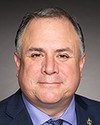Mr. Speaker, the Conservatives like to take the stats and give the impression that everything is still broken in Canada.
Let us look at the types of things done, coming out of the last election, by the Prime Minister and the government, whether it was getting rid of the carbon tax, something that was initiated virtually when the Prime Minister became the Leader of the Liberal Party, or the first substantial pieces of legislation brought in after the election, Bill C-4 and Bill C-5. Bill C-4 gave 22 million Canadians a tax break.
We also then brought in Bill C-5 to build one Canadian economy. On this side of the House, within the Liberal caucus, there is a build Canada strong mentality. We are determined to make Canada the strongest economy in the G7, contrary to what the Conservatives say day after day.
We can look at some of the very basic, fundamental stats. Let us take a look at the labour force participation and contrast it to that of the United States. Canada's labour force participation is far greater than it is in the United States. That does not mean we are not sympathetic to people who are losing jobs; of course we are. That is the reason we have developed five major projects, with more to come before the Grey Cup game.
Of course we are sensitive to the people who are losing jobs, just like we are concerned with the issue of affordability. Let us look at the reality of affordability, year over year. From July to July, inflation was 1.9%. That is well within the markers set up by the Governor of the Bank of Canada. That is why interest rates have gone down. That is why we are in the lower half. We are also doing better than most countries in the G7 on interest rates.
The Conservatives talk about debt. We have the lowest net debt-to-GDP ratio in the entire G7, and the Conservatives know that. They know some of the economic indicators. However, they still go around saying that things are so bad in Canada, and then they criticize the Liberals if we try to portray things in a little more of a positive light, accusing us of trying to pat ourselves on the back. We are expressing the reality of the situation: Canadians of all political stripes outside the chamber are coming together and working together to build one strong Canada.
We have a Prime Minister who went to the United States of America to meet with President Trump to begin negotiations in a very tangible way so we can be there for Canadians. What did the Conservatives say? They said that they want the agreement and that we had said we would have an agreement, and so on. They will just fold, capitulate and do whatever they want. We are not going to do that. We believe we have to be there and get the best deal for Canadians. If that means we have to wait an extra week, two weeks or a month or two, whatever it takes, we are going to achieve the best deal for Canadians. That is what the negotiations are all about.
On building our economy, let us take a look at the projects we have brought forward: LNG in B.C., copper in the prairie provinces, nuclear energy in Ontario, the port in Quebec, and a very aggressive, proactive Atlantic caucus pushing on a number of different projects, just like in Manitoba where we are trying to get into the second round of major projects. Premiers of different political stripes and Canadians of all stripes are working together in order to recognize that these types of investments mean something: $60 billion.
Yesterday in question period, the Conservatives were talking about foreign investment. More countries invested in Canada in 2023; according to the last numbers I saw, we were number one in terms of foreign investment coming into Canada. There is a private sector that the Prime Minister referenced.
Look at what is actually happening; there are a lot of good things taking place in Canada. We just need the Conservatives to open their eyes, or, I would suggest, if they have not learned anything from the last federal election, they will continue to be in opposition for many years to come. I will say that they are good in opposition—









